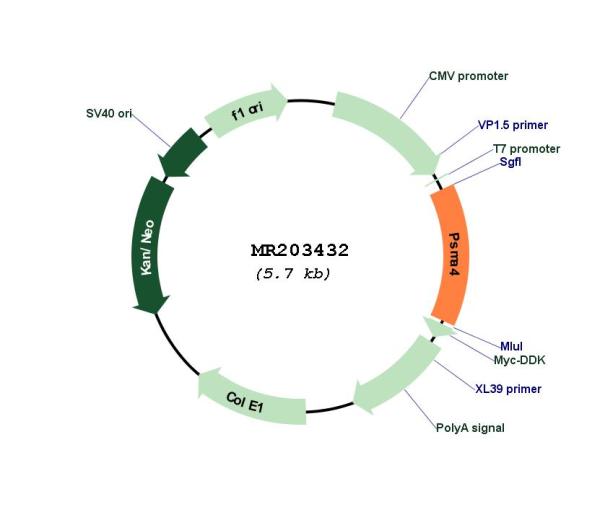Psma4 (NM_011966) Mouse Tagged ORF Clone
CAT#: MR203432
- TrueORF®
Psma4 (Myc-DDK-tagged) - Mouse proteasome (prosome, macropain) subunit, alpha type 4 (Psma4)
ORF Plasmid: tGFP
"NM_011966" in other vectors (3)
Need custom modification / cloning service?
Get a free quote
CNY 1,416.00
CNY 300.00
Specifications
| Product Data | |
| Type | Mouse Tagged ORF Clone |
| Tag | Myc-DDK |
| Synonyms | C9 |
| Vector | pCMV6-Entry |
| E. coli Selection | Kanamycin (25 ug/mL) |
| Mammalian Cell Selection | Neomycin |
| Sequence Data |
>MR203432 ORF sequence
Red=Cloning site Blue=ORF Green=Tags(s) TTTTGTAATACGACTCACTATAGGGCGGCCGGGAATTCGTCGACTGGATCCGGTACCGAGGAGATCTGCC GCCGCGATCGCC ATGTCTCGAAGATATGACTCCAGGACCACAATATTTTCTCCAGAAGGTCGCTTATACCAAGTGGAATATG CCATGGAAGCCATTGGACATGCAGGCACCTGTTTGGGGATTTTAGCCAATGATGGAGTTTTGCTTGCAGC GGAGAGGCGCAACATCCACAAGCTTCTTGATGAAGTCTTCTTTTCTGAGAAAATTTATAAACTTAATGAG GACATGGCTTGCAGCGTGGCAGGCATAACATCTGATGCTAACGTTCTGACTAACGAGCTAAGGCTCATTG CTCAACGGTACTTATTACAGTATCAGGAGCCAATTCCCTGTGAGCAGTTGGTTACAGCACTGTGTGATAT CAAACAGGCGTACACACAGTTTGGAGGCAAACGTCCCTTTGGTGTTTCTTTGCTGTATATTGGCTGGGAT AAGCACTATGGCTTTCAGCTCTATCAGAGTGACCCAAGTGGAAACTATGGCGGATGGAAAGCCACATGCA TTGGGAACAACAGTGCTGCGGCTGTGTCAATGTTGAAACAAGACTACAAAGAAGGAGAAATGACTCTGAA GTCAGCGCTTGCTCTGGCTGTTAAGGTGCTAAATAAGACAATGGATGTTAGTAAACTGTCAGCTGAAAAA GTGGAAATCGCCACACTAACAAGAGAGAGTGGGAAGACGGTGATCAGAGTCCTCAAGCAAAAGGAAGTGG AACAGTTGATCAAAAAACATGAAGAGGAAGAAGCTAAGGCTGAGCGGGAGAAGAAAGAAAAAGAACAGAG AGAAAAGGATAAA ACGCGTACGCGGCCGCTCGAGCAGAAACTCATCTCAGAAGAGGATCTGGCAGCAAATGATATCCTGGATT ACAAGGATGACGACGATAAGGTTTAA >MR203432 protein sequence
Red=Cloning site Green=Tags(s) MSRRYDSRTTIFSPEGRLYQVEYAMEAIGHAGTCLGILANDGVLLAAERRNIHKLLDEVFFSEKIYKLNE DMACSVAGITSDANVLTNELRLIAQRYLLQYQEPIPCEQLVTALCDIKQAYTQFGGKRPFGVSLLYIGWD KHYGFQLYQSDPSGNYGGWKATCIGNNSAAAVSMLKQDYKEGEMTLKSALALAVKVLNKTMDVSKLSAEK VEIATLTRESGKTVIRVLKQKEVEQLIKKHEEEEAKAEREKKEKEQREKDK TRTRPLEQKLISEEDLAANDILDYKDDDDKV |
| Restriction Sites |
SgfI-MluI
Cloning Scheme for this gene
Plasmid Map

|
| ACCN | NM_011966 |
| ORF Size | 786 bp |
| OTI Disclaimer | The molecular sequence of this clone aligns with the gene accession number as a point of reference only. However, individual transcript sequences of the same gene can differ through naturally occurring variations (e.g. polymorphisms), each with its own valid existence. This clone is substantially in agreement with the reference, but a complete review of all prevailing variants is recommended prior to use. More info |
| OTI Annotation | This clone was engineered to express the complete ORF with an expression tag. Expression varies depending on the nature of the gene. |
| Product Components | The ORF clone is ion-exchange column purified and shipped in a 2D barcoded Matrix tube containing 10ug of transfection-ready, dried plasmid DNA (reconstitute with 100 ul of water). |
| Reconstitution | 1. Centrifuge at 5,000xg for 5min. 2. Carefully open the tube and add 100ul of sterile water to dissolve the DNA. 3. Close the tube and incubate for 10 minutes at room temperature. 4. Briefly vortex the tube and then do a quick spin (less than 5000xg) to concentrate the liquid at the bottom. 5. Store the suspended plasmid at -20°C. The DNA is stable for at least one year from date of shipping when stored at -20°C. |
| Reference Data | |
| RefSeq | NM_011966.2 |
| RefSeq Size | 1096 bp |
| RefSeq ORF | 786 bp |
| Locus ID | 26441 |
| UniProt ID | Q9R1P0 |
| MW | 29.5 kDa |
| Gene Summary | Component of the 20S core proteasome complex involved in the proteolytic degradation of most intracellular proteins. This complex plays numerous essential roles within the cell by associating with different regulatory particles. Associated with two 19S regulatory particles, forms the 26S proteasome and thus participates in the ATP-dependent degradation of ubiquitinated proteins. The 26S proteasome plays a key role in the maintenance of protein homeostasis by removing misfolded or damaged proteins that could impair cellular functions, and by removing proteins whose functions are no longer required. Associated with the PA200 or PA28, the 20S proteasome mediates ubiquitin-independent protein degradation. This type of proteolysis is required in several pathways including spermatogenesis (20S-PA200 complex) or generation of a subset of MHC class I-presented antigenic peptides (20S-PA28 complex).[UniProtKB/Swiss-Prot Function] |
Documents
| Product Manuals |
| FAQs |
| SDS |
Resources
Other Versions
| SKU | Description | Size | Price |
|---|---|---|---|
| MG203432 | Psma4 (tGFP-tagged) - Mouse proteasome (prosome, macropain) subunit, alpha type 4 (Psma4) |
CNY 2,850.00 |
|
| MR203432L3 | Lenti ORF clone of Psma4 (Myc-DDK-tagged) - Mouse proteasome (prosome, macropain) subunit, alpha type 4 (Psma4) |
CNY 4,750.00 |
|
| MR203432L4 | Lenti ORF clone of Psma4 (mGFP-tagged) - Mouse proteasome (prosome, macropain) subunit, alpha type 4 (Psma4) |
CNY 4,750.00 |


 United States
United States
 Germany
Germany
 Japan
Japan
 United Kingdom
United Kingdom
 China
China

